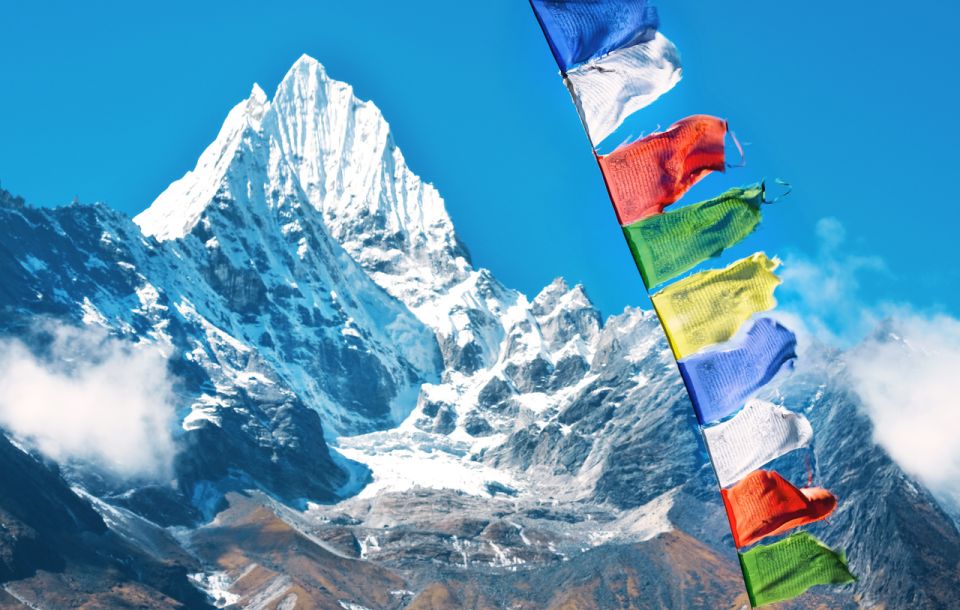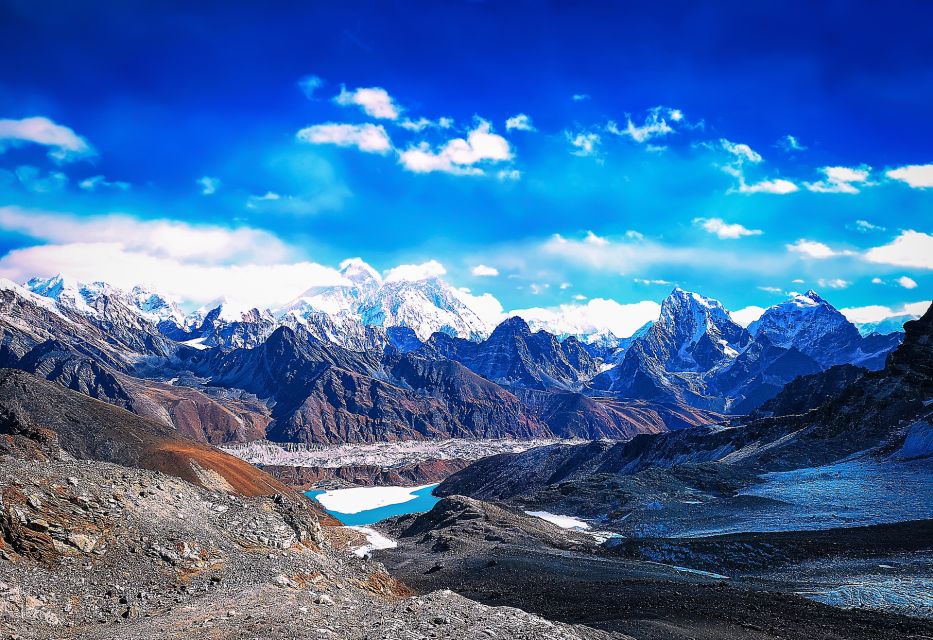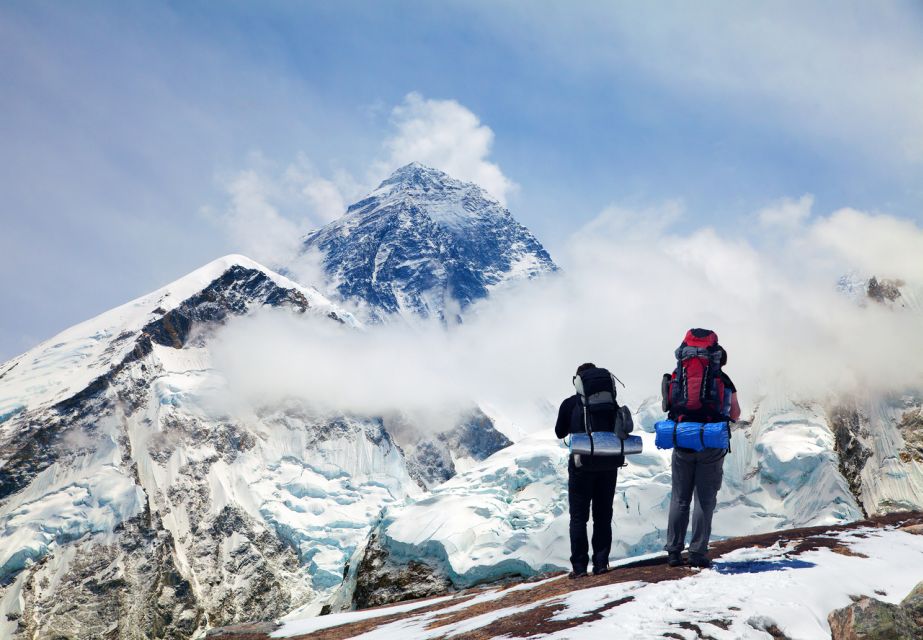Everest Base Camp Trek
Nestled amidst the towering peaks of the Himalayas lies the Everest Base Camp, a destination that marries the adrenaline of adventure with the serenity of nature.
As trekkers traverse through the rugged terrains, a sense of awe and accomplishment fills the air, but what challenges and triumphs await those who embark on this iconic journey?
The allure of reaching the foot of the world’s highest mountain beckons, promising an experience that transcends mere travel.
Key Points

- Proper acclimatization and fitness are crucial for a successful Everest Base Camp trek.
- Packing essentials like trekking gear and sleeping bags is necessary for the challenging terrain.
- Adhere to permit regulations and respect local customs for a safe and respectful trekking experience.
- Prioritize safety, health, and environmental impact by following guidelines and being prepared throughout the journey.
Trek Overview

Set out on an unforgettable journey through the breathtaking landscapes of the Everest Base Camp Trek, enjoying the heart of the Himalayas for 14 days of adventure and discovery.
The trek highlights include stunning views of Mount Everest, Sherpa villages, Tengboche Monastery, and the Khumbu Glacier. The difficulty levels vary from moderate to challenging, with altitudes reaching up to 5,545 meters.
Trekkers should be prepared for long days of hiking, varying weather conditions, and high altitude challenges. Proper acclimatization and physical fitness are crucial for a successful journey.
Despite the demanding terrain, the rewards of reaching Everest Base Camp are unparalleled, making it a bucket-list adventure for avid trekkers and nature enthusiasts alike.
Route and Itinerary

The journey through the Route and Itinerary of the Everest Base Camp Trek unveils a mesmerizing tapestry of diverse landscapes and cultural encounters. Trekkers are treated to breathtaking scenic views of snow-capped peaks, lush forests, and picturesque villages along the way. The route typically covers about 130 kilometers round trip from Lukla to Everest Base Camp and back, with stops at key points like Namche Bazaar, Tengboche Monastery, and Gorak Shep.
Weather conditions play a crucial role in the trek, with temperatures varying from pleasantly cool to freezing at higher altitudes. Trekkers should be prepared for changing weather patterns and altitude-related challenges. Proper gear and acclimatization stops are essential for a safe and enjoyable journey to the iconic Everest Base Camp.
Accommodation and Meals

Navigating through the diverse landscapes and cultural encounters of the Everest Base Camp Trek, trekkers can expect comfortable accommodations and hearty meals along the journey. Accommodation options range from teahouses to lodges, providing cozy rooms with basic amenities like beds and blankets. Trekkers should pack a sleeping bag for added comfort.
Meals are typically carb-heavy to fuel the trek, with options like dal bhat (rice and lentils), soups, noodles, and tea. It’s recommended to carry energy bars and snacks for quick boosts during the trek. Meal planning involves ensuring a balance of carbohydrates, proteins, and fats to sustain energy levels.
Trekkers can enjoy delicious Sherpa cuisine while taking in the breathtaking views of the Himalayas.
Packing Essentials
When preparing for the Everest Base Camp Trek, essential items to pack include:
- High-quality trekking boots
- Lightweight clothing layers
- A warm sleeping bag
- A reliable backpack
Proper clothing layering is crucial for varying temperatures. Pack moisture-wicking base layers, insulating mid-layers, and a waterproof outer shell. Opt for quick-drying fabrics to stay comfortable during the trek.
Footwear suggestions include sturdy, well-broken-in trekking boots with ankle support to navigate rugged terrain comfortably. Don’t forget to bring along a warm sleeping bag suitable for low temperatures at higher altitudes.
A reliable backpack with a hip belt and padded shoulder straps will help distribute weight effectively. Consider packing essentials that are lightweight, versatile, and geared towards outdoor durability for a successful trekking experience.
Altitude and Acclimatization
Altitude sickness can be a serious concern for trekkers as they ascend to higher elevations during the Everest Base Camp Trek. To prevent altitude sickness, proper acclimatization is crucial. Trekkers should allow time for their bodies to adjust to the decreasing oxygen levels by ascending gradually and taking rest days to acclimatize. Adequate hydration is also essential to help combat altitude sickness. Plus, physical training before the trek can improve cardiovascular fitness, making it easier for trekkers to adapt to the higher altitudes. Here is a table summarizing key points for altitude and acclimatization:
| Altitude Sickness | Prevention |
|---|---|
| Proper acclimatization | Ascend gradually |
| Adequate hydration | Rest days |
| Physical training | Cardiovascular fitness |
Permits and Regulations
Before embarking on the Everest Base Camp Trek, travelers must ensure they’ve the necessary permits and are familiar with the regulations in place for the journey. Obtaining the required permits is essential to ensure a smooth trekking experience. Local regulations are strictly enforced to protect the environment and ensure the safety of trekkers. Some key points to consider include:
-
Permit Requirements:
- Travelers need to obtain permits such as the Sagarmatha National Park Entry Permit and the Khumbu Pasang Lhamu Rural Municipality Entrance Permit.
-
Local Regulations:
- Trekkers must abide by waste management regulations.
- Respect local customs and traditions during the trek.
- Follow designated trekking routes to preserve the natural habitat.
Safety and Health Tips
Prior to embarking on the Everest Base Camp Trek, travelers should prioritize their safety and well-being by adhering to essential safety and health tips throughout the journey. It is crucial to understand emergency procedures and ensure access to necessary medical supplies in case of any unforeseen events. Staying hydrated is key; trekkers must drink plenty of water to combat altitude sickness and maintain their energy levels. Plus, meeting the fitness requirements is vital to endure the demanding trek and reduce the risk of injuries. Below is a table summarizing key safety and health tips for a successful Everest Base Camp Trek:
| Safety and Health Tips | |
|---|---|
| Emergency procedures | Medical supplies |
| Hydration | Fitness requirements |
Environmental Impact
To minimize the ecological footprint of the Everest Base Camp Trek, travelers must conscientiously adhere to Leave No Trace principles and actively participate in conservation efforts along the trail. Implementing proper waste management practices is crucial to preserving the pristine environment of the Himalayas.
By reducing, reusing, and recycling waste, trekkers can significantly lessen their impact on the fragile ecosystem. Plus, being mindful of their carbon footprint is essential. Choosing eco-friendly travel options, such as using refillable water bottles instead of single-use plastics, can help decrease carbon emissions.
Engaging in tree-planting initiatives or supporting local conservation projects are meaningful ways for trekkers to give back to the environment they’re exploring.
Common questions

Is It Possible to Charge Electronic Devices During the Trek?
Yes, it’s possible to charge electronic devices during the trek using solar chargers or battery packs. These portable solutions provide a reliable way to keep devices powered up, ensuring you stay connected and capture memories along the journey.
Are There Any Opportunities for Cultural Experiences or Interactions With Local Communities Along the Trek?
Local interactions and cultural experiences enhance any trek. Meeting local communities along the route provides insight into traditions and lifestyles. Engaging with locals can offer a deeper appreciation for the area’s heritage and create memorable connections.
Can I Rent Trekking Gear or Equipment at the Starting Point of the Trek?
Gear rental options are available at the starting point for convenience. Prices vary based on the item, but quality is assured. Availability could be limited during peak seasons, so it’s wise to inquire in advance.
Are There Any Wi-Fi or Internet Connectivity Options Available Along the Trek Route?
In remote trekking areas, Tea houses along the route may offer limited Wi-Fi connectivity, providing basic communication options. However, it’s advisable to not rely solely on this for internet access due to potential connectivity challenges.
What Is the Availability of Medical Facilities or Emergency Evacuation Services Along the Trekking Route?
In remote trekking routes, medical facilities can be scarce. Altitude sickness is a common concern, so having first aid training is crucial. Emergency evacuation services may be limited, making preparedness and caution vital.
Last Words
Embark on the Everest Base Camp trek for an unforgettable adventure through the stunning Himalayas. With flexible booking options, essential details covered, and breathtaking landscapes awaiting, this 14-day journey promises an experience like no other.
From cultural richness to rugged terrains, every step brings new wonders to explore. Join fellow trekkers in this remarkable expedition, where the grandeur of the world’s highest peak awaits.
Don’t miss out on this unparalleled exploration opportunity!